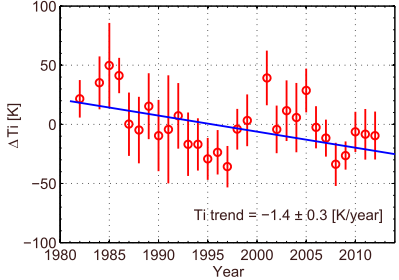Upper atmosphere cooling over the past 33 years (Ogawa et al., GRL, 2014)2017.2.18
Theoretical models and observations have suggested that the increasing greenhouse gas concentration in the troposphere causes the upper atmosphere to cool and contract. However, our understanding of the long-term trends in the upper atmosphere is still quite incomplete, due to a limited amount of available and well-calibrated data. The European Incoherent Scatter (EISCAT) radar has gathered data in the polar ionosphere above Tromsø for over 33 years. Using this long-term data set, we have estimated the first significant trends of ion temperature at altitudes between 200 and 450 km. The estimated trends indicate a cooling of 10-15 K/decade near the F region peak (220-380 km altitude), whereas above 400 km the trend is nearly zero or even warming. The height profiles of the observed trends are close to those predicted by recent atmospheric general circulation models. Our results are the first quantitative confirmation of the simulations and of the qualitative expectations.
カテゴリ:Atmosphere,Long Term

